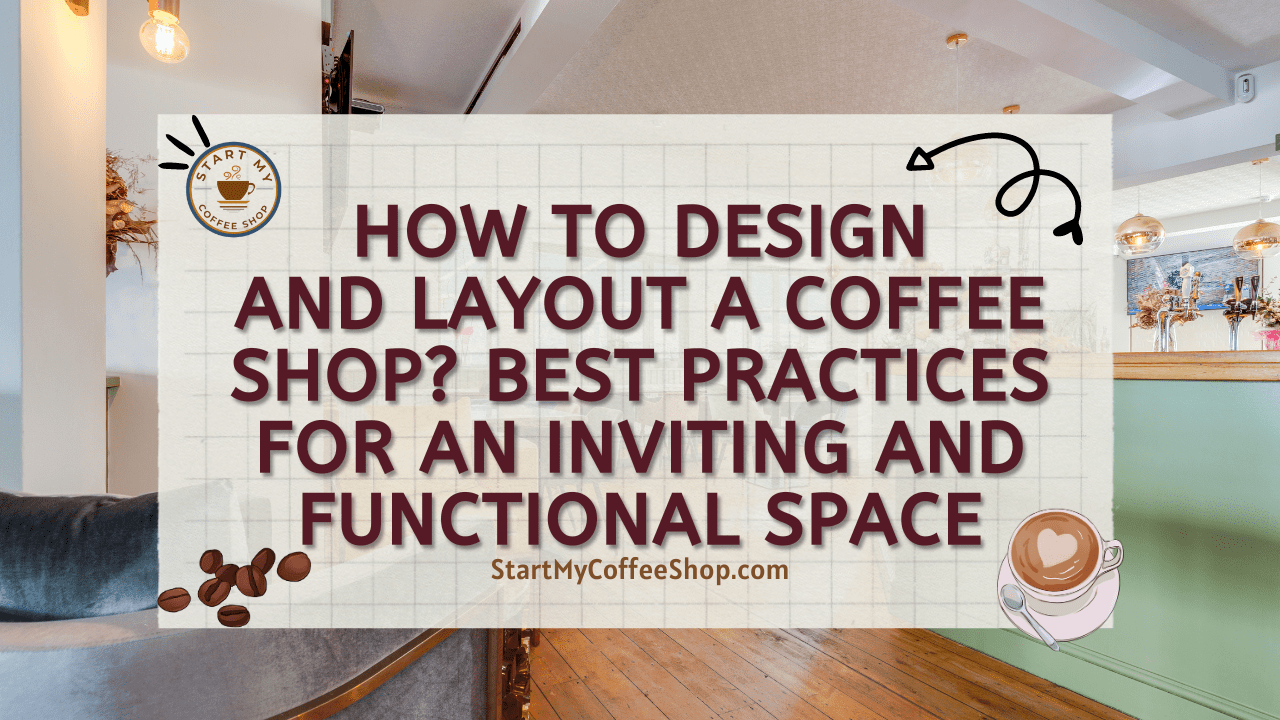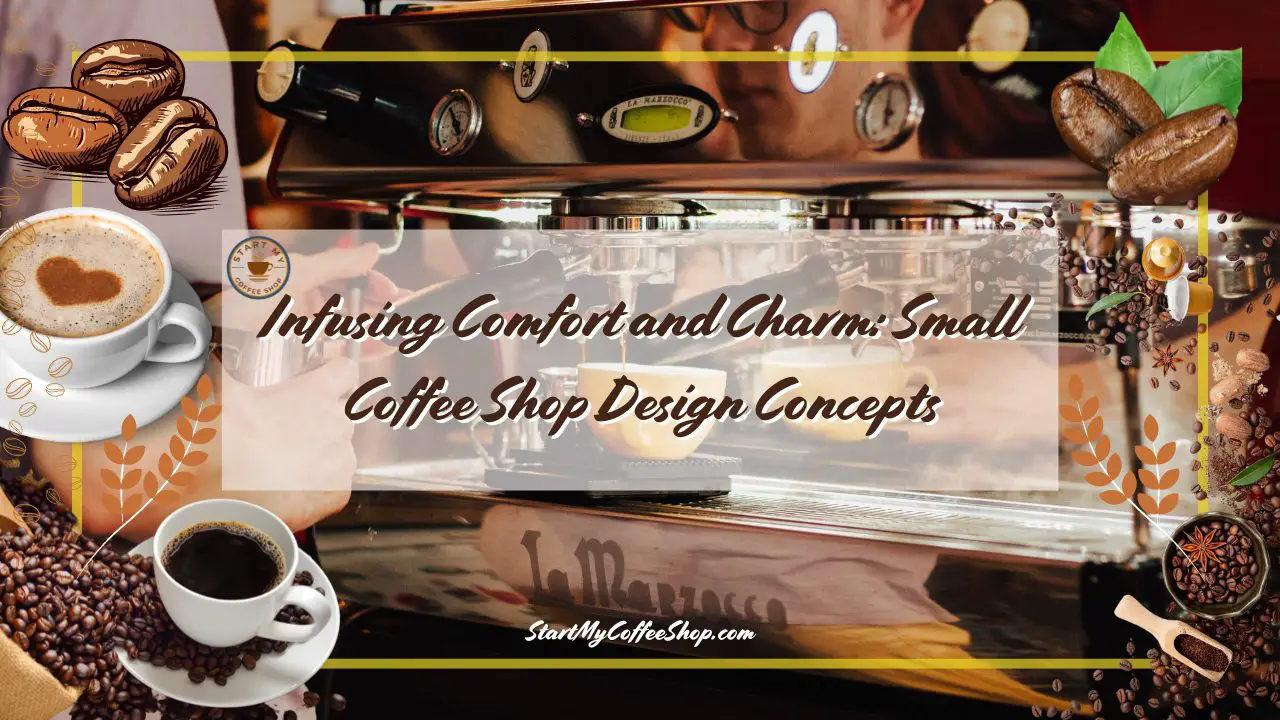Designing and laying out a coffee shop involves careful thought and consideration to create an inviting and functional space that will attract and satisfy customers. From optimizing traffic flow to creating a cozy ambiance, every aspect plays a crucial role in shaping the overall experience.
Key considerations for designing a coffee shop: optimize traffic flow, provide comfortable seating, incorporate natural lighting, create a cozy ambiance, consider ergonomic workspace for baristas, prioritize storage, and ensure efficient customer service areas.
In this article, I will explore some key considerations and best practices to help you design and lay out a coffee shop that delights your customers.
1. Define Your Concept and Target Audience
 Before embarking on the design process of your coffee shop, it is crucial to have a clear understanding of your concept and identify your target audience. Defining your coffee shop’s concept involves envisioning the atmosphere, style, and overall experience you want to create. Are you aiming for a cozy and intimate neighborhood café that exudes a sense of familiarity and comfort? Or do you envision a trendy and modern urban espresso bar, catering to a hip and fast-paced clientele?
Before embarking on the design process of your coffee shop, it is crucial to have a clear understanding of your concept and identify your target audience. Defining your coffee shop’s concept involves envisioning the atmosphere, style, and overall experience you want to create. Are you aiming for a cozy and intimate neighborhood café that exudes a sense of familiarity and comfort? Or do you envision a trendy and modern urban espresso bar, catering to a hip and fast-paced clientele?
By clearly defining your concept, you can align your design choices to create a space that resonates with your target audience. Understanding your target audience is essential in tailoring the ambiance and aesthetics to their preferences and expectations. Consider factors such as age, lifestyle, interests, and demographics when determining your target audience.
For instance, if your target audience consists of young professionals seeking a vibrant and energetic atmosphere, you may opt for a modern and sleek design with an open layout, contemporary furniture, and dynamic lighting. On the other hand, if your coffee shop caters to families and individuals looking for a cozy and relaxed environment, you might choose warm colors, comfortable seating options, and soft lighting to create a welcoming and inviting space.
Aligning your design choices with your concept and target audience ensures that your coffee shop creates the desired ambiance and resonates with your customers. It helps in crafting an experience that matches their expectations and encourages them to return.
2. Optimize Traffic Flow
 Efficient traffic flow is a cornerstone of a well-designed coffee shop, playing a vital role in creating a smooth and enjoyable customer experience. When considering the layout of your space, it is crucial to plan for a logical flow of movement that seamlessly guides customers through their coffee journey.
Efficient traffic flow is a cornerstone of a well-designed coffee shop, playing a vital role in creating a smooth and enjoyable customer experience. When considering the layout of your space, it is crucial to plan for a logical flow of movement that seamlessly guides customers through their coffee journey.
Firstly, pay attention to the positioning of the entrance and counter. The entrance should be easily accessible and visible, allowing customers to enter without confusion. Placing the counter near the entrance enables customers to approach it effortlessly to place their orders. This intuitive arrangement minimizes any initial confusion and ensures a seamless start to their coffee shop experience.
To maintain smooth traffic flow within the coffee shop, provide adequate space between seating areas and service stations. Overcrowded or cramped spaces can lead to congestion, making it difficult for customers to navigate and enjoy their visit. Consider the arrangement of tables and chairs, allowing for enough space for customers to move around comfortably without feeling restricted. Strategic placement of service stations, such as beverage preparation areas and pickup counters, will further contribute to a streamlined flow.
When designing the layout, visualize the customer journey from entering the coffee shop to ordering, receiving their drinks, and finding a seat. Optimize the flow by creating clear pathways that guide customers through each step. Minimize any potential bottlenecks or obstructions by ensuring there are ample circulation areas between various sections of the coffee shop.
By meticulously planning the traffic flow, you enhance the overall functionality of your coffee shop. Customers will appreciate the ease of movement, avoiding any frustrations that may arise from a poorly designed layout. A well-thought-out traffic flow not only improves the customer experience but also boosts operational efficiency, allowing baristas to serve customers more effectively.
3. Seating Arrangements and Comfort
Consider incorporating cozy armchairs or plush sofas for those seeking relaxation and a cozy ambiance. These seating options create a sense of comfort and encourage customers to unwind and savor their coffee at a leisurely pace. Pair them with small side tables to provide convenience for placing beverages or personal belongings.
To foster social interactions, include communal tables where customers can gather and engage in conversations. These larger tables not only facilitate a sense of community but also provide flexibility for groups of friends or colleagues to enjoy their time together. By fostering a social atmosphere, you create an environment that encourages customers to spend more time in your coffee shop.
Additionally, individual tables are essential for customers who prefer a more focused and private setting. These tables cater to individuals seeking a space for reading, working, or studying. Make sure to provide adequate lighting and consider incorporating electrical outlets for customers who may need to charge their devices.
When selecting chairs, prioritize ergonomics to ensure optimal comfort and support. Look for chairs with proper backrests and cushioning that provide a comfortable seating experience. Ergonomic chairs promote good posture, preventing discomfort or fatigue that may detract from the overall enjoyment of your customers.
Another factor to consider is the arrangement of the seating. Create a layout that allows for both privacy and ease of movement. Balance the need for personal space while ensuring customers can navigate through the seating area without obstructions. Adequate spacing between tables and chairs promotes a relaxed and uncluttered environment.
Encourage customers to linger by providing cozy seating arrangements that invite them to stay longer. Soft lighting, warm colors, and comfortable seating work together to create a welcoming ambiance. Consider incorporating cozy elements like cushions, throws, or rugs to enhance comfort and add a touch of homeliness to the seating area.
Read more about Cost to Start Drive-Thru Coffee Shop: A Cupful of Expenses
4. Lighting and Ambiance
Lighting plays a significant role in setting the mood and ambiance of your coffee shop. By carefully considering the lighting design, you can create a warm and inviting atmosphere that enhances the overall customer experience. A combination of natural and artificial lighting can work together harmoniously to achieve the desired effect.
Maximizing natural light is an excellent starting point. Incorporate large windows and skylights in your coffee shop design to allow ample natural light to flood the space. Natural light creates a sense of openness and connection with the outdoors, imparting a fresh and vibrant feel. It also helps to create a more visually appealing environment, making the space feel welcoming and inviting.
In addition to natural light, utilize artificial lighting fixtures strategically. Opt for soft, warm-toned lighting sources to create a cozy ambiance. Consider pendant lights, wall sconces, or table lamps that emit a gentle and inviting glow. Place lighting fixtures strategically to highlight key areas such as the counter, seating arrangements, and artwork displays. This not only draws attention to important features but also adds depth and visual interest to your coffee shop.
To ensure a comfortable atmosphere throughout the day, it’s essential to adjust the lighting levels accordingly. Brighter lighting might be suitable during morning hours to energize customers, while softer and dimmer lighting can create a relaxed and intimate atmosphere in the evening. Consider implementing lighting controls or dimmer switches to allow for easy adjustments and customization of lighting levels based on the time of day or desired ambiance.
5. Thoughtful Interior Design
The interior design of your coffee shop should be a reflection of your brand and concept, creating a visually cohesive and inviting space for your customers. The choice of color scheme plays a significant role in establishing the overall theme and atmosphere. Select colors that align with your brand identity and create a harmonious look throughout the space. For example, if your concept is focused on a cozy and rustic vibe, earthy tones like warm browns, soft greens, and muted oranges can help to create a warm and welcoming ambiance.
Incorporating natural elements into your interior design can add freshness and a touch of nature. Consider placing potted plants strategically throughout the space to bring life and greenery indoors. Not only do plants enhance aesthetic appeal, but they also contribute to a sense of tranquility and well-being. Choose plants that are suitable for indoor environments and require minimal maintenance to ensure they thrive in your coffee shop.
Artwork or photographs can be powerful elements in creating a sense of warmth and community. Display pieces that align with your coffee shop’s concept and evoke emotions that resonate with your customers. Whether it’s local artwork, photographs of coffee-producing regions, or images that reflect the coffee culture, carefully curated pieces can add personality and create a connection with your customers.
Textures, materials, and furniture choices should complement your design concept and enhance the overall aesthetic appeal. Consider incorporating elements like exposed brick, reclaimed wood, or textured wallpapers to add depth and visual interest to your coffee shop. Select furniture that is not only comfortable but also aligns with your concept. From rustic wooden tables and chairs to sleek modern designs, choose pieces that enhance the overall theme and provide a comfortable and inviting seating experience for your customers.
6. Barista Workspace and Efficiency
Creating a well-designed barista workspace is crucial for ensuring smooth operations and efficient service in your coffee shop. When setting up the coffee preparation area, prioritize ergonomics to promote comfort and productivity for your baristas. Place essential tools such as the espresso machine, grinder, and brewing equipment within easy reach, minimizing the need for unnecessary movement and allowing baristas to work efficiently.
Additionally, provide ample counter space for drink preparation and customer interaction. A spacious and well-organized workspace enables baristas to handle multiple orders simultaneously without feeling cramped or overwhelmed. This promotes a seamless workflow and enhances customer satisfaction by minimizing wait times.
Organize ingredients and supplies in a logical and accessible manner. Utilize storage solutions such as labeled containers, shelves, and drawers to keep everything neatly arranged and within reach. This organization minimizes downtime caused by searching for items and maximizes productivity by allowing baristas to quickly access the necessary ingredients and tools.
Regularly assess the efficiency of your barista workspace and make adjustments as needed. Seek feedback from your baristas to identify any potential improvements or areas that may hinder their workflow. By prioritizing ergonomics, accessibility, and organization in the barista workspace, you create an environment that fosters efficiency, enhances the customer experience, and supports your staff in delivering excellent service.
7. Storage and Organization
Maintaining an organized and clutter-free coffee shop is vital for both functional operations and aesthetic appeal. When designing your coffee shop, allocate adequate storage spaces for ingredients, supplies, and equipment. Strategic placement of shelving units, cabinets, and storage areas allows for efficient organization and keeps everything neat and easily accessible.
Consider the specific needs of your coffee shop and the items that require storage. Plan for designated areas for coffee beans, syrups, cups, utensils, cleaning supplies, and other essentials. Utilize shelves and cabinets to store these items in an organized manner, ensuring they are easily identifiable and accessible when needed.
Implement a labeling system to further enhance the organization. Clearly label each storage area to indicate its contents, making it effortless for baristas to locate specific items quickly. This reduces time wasted searching for ingredients or supplies, allowing for a smoother workflow and increased efficiency.
An organized and clutter-free coffee shop not only enhances functionality but also contributes to the overall aesthetic appeal. When customers enter a clean and well-organized space, it leaves a positive impression and adds to their enjoyment of the coffee shop experience.
Read more about Cost to Start Dunkin’s Coffee Shop: Analyzing the Cost Factors
8. Customer Service Areas
Efficiency is paramount when designing customer service areas in your coffee shop. Position order and pickup counters in easily accessible locations, minimizing any potential confusion or congestion. This allows customers to approach these areas effortlessly, streamlining the ordering process.
Consider incorporating self-service stations for condiments, napkins, and utensils. These stations empower customers to customize their beverages and access additional items conveniently, reducing the need for staff intervention and expediting the overall service. Well-organized and stocked self-service stations ensure that customers can quickly find what they need, enhancing their experience and minimizing waiting times.
To further facilitate a seamless ordering experience, provide clear signage and menu displays. Clearly label each section of the counter and prominently display the menu, making it easy for customers to navigate and choose their desired items. Well-designed signage and displays create a sense of clarity and guide customers through the ordering process with ease.
9. Functional Restrooms
Restroom design is an aspect that is often overlooked but plays a vital role in ensuring customer satisfaction. To create a positive experience for your customers, it is important to prioritize the design and maintenance of your restrooms.
First and foremost, cleanliness is crucial. Regularly clean and maintain your restrooms to ensure they are spotless and hygienic. Pay attention to details such as regularly replenishing supplies like soap, toilet paper, and paper towels.
Choose durable and easy-to-clean materials for fixtures and finishes in your restrooms. Opt for materials that are resistant to stains and damage, ensuring that your restrooms maintain a fresh and well-maintained appearance over time.
Lighting, ventilation, and privacy are also important considerations. Ensure that your restrooms are well-lit, allowing customers to feel comfortable and confident in the space. Proper ventilation is essential for air circulation and to eliminate odors. Additionally, prioritize privacy by incorporating features like lockable doors and soundproofing to create a sense of security and comfort for your customers.
A well-designed restroom leaves a lasting impression on customers and contributes to their overall comfort. When restrooms are clean, well-maintained, easily accessible, and designed with attention to lighting, ventilation, and privacy, customers will appreciate the thought and care put into their experience.
10. Evolving and Adapting
Designing a coffee shop is not a one-time endeavor; it’s an ongoing process that requires attentiveness and adaptability. To ensure the longevity of your coffee shop, it’s crucial to continuously seek feedback from your customers and make necessary adjustments based on their preferences and suggestions. By actively listening to their opinions, you can identify areas that require improvement or modification.
Another key aspect of maintaining an inviting and functional coffee shop is staying updated with industry trends. The coffee industry is dynamic and ever-evolving, with new concepts, design ideas, and technologies emerging regularly.
By staying informed about the latest trends, you can incorporate fresh ideas into your space and remain competitive in the market. Whether it’s implementing innovative brewing techniques or adopting sustainable practices, keeping up with industry developments allows you to provide a contemporary and engaging experience for your customers.
Regularly assessing your layout and design is vital to identify areas for improvement. Analyze the traffic flow within your coffee shop and evaluate if any adjustments are needed to optimize the customer experience. Consider the seating arrangements and comfort levels of your furniture, ensuring they align with the preferences of your target audience. If you notice any bottlenecks or areas where customers experience difficulties, take prompt action to address them.
Moreover, periodically reviewing your design and layout allows you to capitalize on emerging opportunities. Perhaps you’ve noticed a rising demand for coworking spaces or an increasing interest in specialty coffee brewing methods. By proactively adapting your design to cater to these trends, you can attract new customers and cater to evolving consumer preferences.
Incorporating new ideas and making necessary changes to your design and layout not only keeps your coffee shop fresh and exciting but also demonstrates your commitment to providing an exceptional experience for your customers. It shows that you value their feedback and are dedicated to continuously improving your offerings.
Summary
Designing and laying out a coffee shop involves a careful balance of functionality and aesthetics. By considering key factors such as traffic flow, seating arrangements, lighting, interior design, and customer service areas, you can create a space that not only attracts customers but also provides them with a delightful experience.
Remember to stay true to your concept, adapt to changing needs, and continuously strive for excellence. Cheers to creating an inviting and functional coffee shop!
Frequently Asked Questions
Q: How important is the layout of a coffee shop for the overall customer experience?
A: An efficient and well-designed layout ensures smooth traffic flow, comfortable seating arrangements, and easy access to service areas, ultimately enhancing customer satisfaction.
Q: What role does lighting play in designing a coffee shop?
A: Well-planned lighting, including a mix of natural and artificial sources, sets the mood, highlights key areas, and contributes to the overall cozy and inviting atmosphere.
Q: What are some key considerations for selecting furniture and seating options in a coffee shop?
A: Opt for comfortable chairs that provide support, and offer a variety of seating options to cater to different customer preferences, such as cozy armchairs, communal tables, and individual workstations.
To learn more on how to start your own coffee shop checkout my startup documents here
Please note: This blog post is for educational purposes only and does not constitute legal advice. Please consult a legal expert to address your specific needs.

Hi! I’m Shawn Chun
My adventure in coffee began when I first launched my first coffee shop back in the early 2000s. I had to figure out so many things on my own and to make it worse within 2 years of opening two large corporate coffee chains moved in just blocks away from me!
As I saw smaller and even some larger coffee shops in the neighborhood slowly lose customers to these giant coffee chains and slowly close up shop, I knew that I had to start getting creative…or go out of business.
I (like you may be) knew the coffee industry well. I could make the best latte art around and the foam on my caps was the fluffiest you have ever seen. I even had the best state-of-the-art 2 group digital Nuova Simonelli machine money could buy. But I knew that these things alone would not be enough to lure customers away from the name brand established coffee shops.
Eventually, through lots of trial and error as well as perseverance and creativity I did find a way to not only survive but also thrive in the coffee/espresso industry even while those corporate coffee chains stayed put. During those years I learned to adapt and always faced new challenges. It was not always easy, however, in the end, I was the sole survivor independent coffee shop within a 10-mile radius of my location. Just two corporate coffee chains and I were left after that year. All told the corporate coffee chains took down over 15 small independent coffee shops and kiosks and I was the last one standing and thriving.
Along the years I meet others with the same passion for coffee and I quickly learned that it is not only “how good a barista is” that makes a coffee shop successful, but the business side of coffee as well.
Hence why I started this website you are on now. To provide the tools and resources for up and coming coffee shop owners to gain that vital insight and knowledge on how to start a coffee shop successfully.
Stick around, browse through my helpful blog and resources and enjoy your stay! With lots of LATTE LOVE!
Shawn






